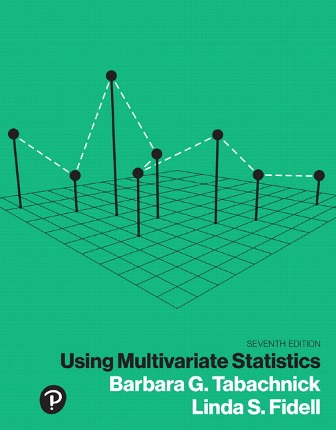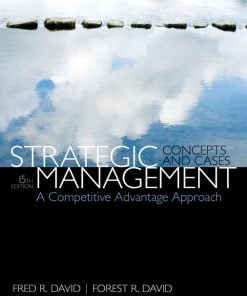Solution Manual for Using Multivariate Statistics 7th Edition Barbara G. Tabachnick, Linda S. Fidell
$35.00 Original price was: $35.00.$26.50Current price is: $26.50.
Solution Manual for Using Multivariate Statistics 7th Edition Barbara G. Tabachnick, Linda S. Fidell,
This is completed downloadable of Solution Manual for Using Multivariate Statistics 7th Edition Barbara G. Tabachnick, Linda S. Fidell

Product Details:
- ISBN-10 : 0134790545
- ISBN-13 : 978-0134790541
- Author: Barbara G. Tabachnick, Linda S. Fidell
Using Multivariate Statistics, 7th Edition presents complex statistical procedures in a way that is maximally useful and accessible to researchers who may not be statisticians. The authors focus on the benefits and limitations of applying a technique to a data set – when, why, and how to do it. Only a limited knowledge of higher-level mathematics is assumed.
Students using this text will learn to conduct numerous types of multivariate statistical analyses; find the best technique to use; understand limitations to applications; and learn how to use SPSS and SAS syntax and output.
Table of Content:
- Chapter 1 Introduction
- Learning Objectives
- 1.1 Multivariate Statistics: Why?
- 1.1.1 The Domain of Multivariate Statistics: Numbers of IVs and DVs
- 1.1.2 Experimental and Nonexperimental Research
- 1.1.3 Computers and Multivariate Statistics
- 1.1.4 Garbage In, Roses Out?
- 1.2 Some Useful Definitions
- 1.2.1 Continuous, Discrete, and Dichotomous Data
- 1.2.2 Samples and Populations
- 1.2.3 Descriptive and Inferential Statistics
- 1.2.4 Orthogonality: Standard and Sequential Analyses
- 1.3 Linear Combinations of Variables
- 1.4 Number and Nature of Variables to Include
- 1.5 Statistical Power
- 1.6 Data Appropriate for Multivariate Statistics
- 1.6.1 The Data Matrix
- 1.6.2 The Correlation Matrix
- 1.6.3 The Variance–Covariance Matrix
- 1.6.4 The Sum-of-Squares and Cross-Products Matrix
- 1.6.5 Residuals
- 1.7 Organization of the Book
- Chapter 2 A Guide to Statistical Techniques Using the Book
- Learning Objectives
- 2.1 Research Questions and Associated Techniques
- 2.1.1 Degree of Relationship Among Variables
- 2.1.1.1 Bivariate r
- 2.1.1.2 Multiple R
- 2.1.1.3 Sequential R
- 2.1.1.4 Canonical R
- 2.1.1.5 Multiway Frequency Analysis
- 2.1.1.6 Multilevel Modeling
- 2.1.2 Significance of Group Differences
- 2.1.2.1 One-Way ANOVA and t Test
- 2.1.2.2 One-Way ANCOVA
- 2.1.2.3 Factorial ANOVA
- 2.1.2.4 Factorial ANCOVA
- 2.1.2.5 Hotelling’s T2
- 2.1.2.6 One-Way MANOVA
- 2.1.2.7 One-Way MANCOVA
- 2.1.2.8 Factorial MANOVA
- 2.1.2.9 Factorial MANCOVA
- 2.1.2.10 Profile Analysis of Repeated Measures
- 2.1.3 Prediction of Group Membership
- 2.1.3.1 One-Way Discriminant Analysis
- 2.1.3.2 Sequential One-Way Discriminant Analysis
- 2.1.3.3 Multiway Frequency Analysis (Logit)
- 2.1.3.4 Logistic Regression
- 2.1.3.5 Sequential Logistic Regression
- 2.1.3.6 Factorial Discriminant Analysis
- 2.1.3.7 Sequential Factorial Discriminant Analysis
- 2.1.4 Structure
- 2.1.4.1 Principal Components
- 2.1.4.2 Factor Analysis
- 2.1.4.3 Structural Equation Modeling
- 2.1.5 Time Course of Events
- 2.1.5.1 Survival/Failure Analysis
- 2.1.5.2 Time-Series Analysis
- 2.2 Some Further Comparisons
- 2.3 A Decision Tree
- 2.4 Technique Chapters
- 2.5 Preliminary Check of the Data
- Chapter 3 Review of Univariate and Bivariate Statistics
- Learning Objectives
- 3.1 Hypothesis Testing
- 3.1.1 One-Sample z Test as Prototype
- 3.1.2 Power
- 3.1.3 Extensions of the Model
- 3.1.4 Controversy Surrounding Significance Testing
- 3.2 Analysis of Variance
- 3.2.1 One-Way Between-Subjects ANOVA
- 3.2.2 Factorial Between-Subjects ANOVA
- 3.2.3 Within-Subjects ANOVA
- 3.2.4 Mixed Between-Within-Subjects ANOVA6
- 3.2.5 Design Complexity
- 3.2.5.1 Nesting
- 3.2.5.2 Latin-Square Designs
- 3.2.5.3 Unequal n and Nonorthogonality
- 3.2.5.4 Fixed and Random Effects
- 3.2.6 Specific Comparisons
- 3.2.6.1 Weighting Coefficients for Comparisons
- 3.2.6.2 Orthogonality of Weighting Coefficients
- 3.2.6.3 Obtained F for Comparisons
- 3.2.6.4 Critical F for Planned Comparisons
- 3.2.6.5 Critical F for Post Hoc Comparisons
- 3.3 Parameter Estimation
- 3.4 Effect Size
- 3.5 Bivariate Statistics: Correlation and Regression
- 3.5.1 Correlation
- 3.5.2 Regression
- 3.6 Chi-Square Analysis
- Chapter 4 Cleaning Up Your Act Screening Data Prior to Analysis
- Learning Objectives
- 4.1 Important Issues in Data Screening
- 4.1.1 Accuracy of Data File
- 4.1.2 Honest Correlations
- 4.1.2.1 Inflated Correlation
- 4.1.2.2 Deflated Correlation
- 4.1.3 Missing Data
- 4.1.3.1 Deleting Cases or Variables
- 4.1.3.2 Estimating Missing Data
- 4.1.3.3 Using a Missing Data Correlation Matrix
- 4.1.3.4 Treating Missing Data as Data
- 4.1.3.5 Repeating Analyses With and Without Missing Data
- 4.1.3.6 Choosing Among Methods for Dealing With Missing Data
- 4.1.4 Outliers
- 4.1.4.1 Detecting Univariate and Multivariate Outliers
- 4.1.4.2 Describing Outliers
- 4.1.4.3 Reducing the Influence of Outliers
- 4.1.4.4 Outliers in a Solution
- 4.1.5 Normality, Linearity, and Homoscedasticity
- 4.1.5.1 Normality
- 4.1.5.2 Linearity
- 4.1.5.3 Homoscedasticity, Homogeneity of Variance, and Homogeneity of Variance–Covariance Matrices
- 4.1.6 Common Data Transformations
- 4.1.7 Multicollinearity and Singularity
- 4.1.8 A Checklist and Some Practical Recommendations
- 4.2 Complete Examples of Data Screening
- 4.2.1 Screening Ungrouped Data
- 4.2.1.1 Accuracy of Input, Missing Data, Distributions, and Univariate Outliers
- 4.2.1.2 Linearity and Homoscedasticity
- 4.2.1.3 Transformation
- 4.2.1.4 Detecting Multivariate Outliers
- 4.2.1.5 Variables Causing Cases to Be Outliers
- 4.2.1.6 Multicollinearity
- 4.2.2 Screening Grouped Data
- 4.2.2.1 Accuracy of Input, Missing Data, Distributions, Homogeneity of Variance, and Univariate Outliers
- 4.2.2.2 Linearity
- 4.2.2.3 Multivariate Outliers
- 4.2.2.4 Variables Causing Cases to be Outliers
- 4.2.2.5 Multicollinearity
- Chapter 5 Multiple Regression
- Learning Objectives
- 5.1 General Purpose and Description
- 5.2 Kinds of Research Questions
- 5.2.1 Degree of Relationship
- 5.2.2 Importance of IVs
- 5.2.3 Adding IVs
- 5.2.4 Changing IVs
- 5.2.5 Contingencies Among IVs
- 5.2.6 Comparing Sets of IVs
- 5.2.7 Predicting DV Scores for Members of a New Sample
- 5.2.8 Parameter Estimates
- 5.3 Limitations to Regression Analyses
- 5.3.1 Theoretical Issues
- 5.3.2 Practical Issues
- 5.3.2.1 Ratio of Cases to IVs
- 5.3.2.2 Absence of Outliers Among the IVs and on the DV
- 5.3.2.3 Absence of Multicollinearity and Singularity
- 5.3.2.4 Normality, Linearity, and Homoscedasticity of Residuals
- 5.3.2.5 Independence of Errors
- 5.3.2.6 Absence of Outliers in the Solution
- 5.4 Fundamental Equations for Multiple Regression
- 5.4.1 General Linear Equations
- 5.4.2 Matrix Equations
- 5.4.3 Computer Analyses of Small-Sample Example
- 5.5 Major Types of Multiple Regression
- 5.5.1 Standard Multiple Regression
- 5.5.2 Sequential Multiple Regression
- 5.5.3 Statistical (Stepwise) Regression
- 5.5.4 Choosing Among Regression Strategies
- 5.6 Some Important Issues
- 5.6.1 Importance of IVs
- 5.6.1.1 Standard Multiple Regression
- 5.6.1.2 Sequential or Statistical Regression
- 5.6.1.3 Commonality Analysis
- 5.6.1.4 Relative Importance Analysis
- 5.6.2 Statistical Inference
- 5.6.2.1 Test for Multiple R
- 5.6.2.2 Test of Regression Components
- 5.6.2.3 Test of Added Subset of IVs
- 5.6.2.4 Confidence Limits
- 5.6.2.5 Comparing Two Sets of Predictors
- 5.6.3 Adjustment of R2
- 5.6.4 Suppressor Variables
- 5.6.5 Regression Approach to ANOVA
- 5.6.6 Centering When Interactions and Powers of IVs are Included
- 5.6.7 Mediation in Causal Sequence
- 5.7 Complete Examples of Regression Analysis
- 5.7.1 Evaluation of Assumptions
- 5.7.1.1 Ratio of Cases to IVs
- 5.7.1.2 Normality, Linearity, Homoscedasticity, and Independence of Residuals
- 5.7.1.3 Outliers
- 5.7.1.4 Multicollinearity and Singularity
- 5.7.2 Standard Multiple Regression
- 5.7.3 Sequential Regression
- 5.7.4 Example of Standard Multiple Regression with Missing Values Multiply Imputed
- 5.8 Comparison of Programs
- 5.8.1 IBM SPSS Package
- 5.8.2 SAS System
- 5.8.3 SYSTAT System
- Chapter 6 Analysis of Covariance
- Learning Objectives
- 6.1 General Purpose and Description
- 6.2 Kinds of Research Questions
- 6.2.1 Main Effects of IVs
- 6.2.2 Interactions Among IVs
- 6.2.3 Specific Comparisons and Trend Analysis
- 6.2.4 Effects of Covariates
- 6.2.5 Effect Size
- 6.2.6 Parameter Estimates
- 6.3 Limitations to Analysis of Covariance
- 6.3.1 Theoretical Issues
- 6.3.2 Practical Issues
- 6.3.2.1 Unequal Sample Sizes, Missing Data, and Ratio of Cases to IVs
- 6.3.2.2 Absence of Outliers
- 6.3.2.3 Absence of Multicollinearity and Singularity
- 6.3.2.4 Normality of Sampling Distributions
- 6.3.2.5 Homogeneity of Variance
- 6.3.2.6 Linearity
- 6.3.2.7 Homogeneity of Regression
- 6.3.2.8 Reliability of Covariates
- 6.4 Fundamental Equations for Analysis of Covariance
- 6.4.1 Sums of Squares and Cross-Products
- 6.4.2 Significance Test and Effect Size
- 6.4.3 Computer Analyses of Small-Sample Example
- 6.5 Some Important Issues
- 6.5.1 Choosing Covariates
- 6.5.2 Evaluation of Covariates
- 6.5.3 Test for Homogeneity of Regression
- 6.5.4 Design Complexity
- 6.5.4.1 Within-Subjects and Mixed Within-Between Designs
- 6.5.4.1.1 Same Covariate(s) for All Cells
- 6.5.4.1.2 Varying Covariate(s) Over Cells
- 6.5.4.2 Unequal Sample Sizes
- 6.5.4.3 Specific Comparisons and Trend Analysis
- 6.5.4.4 Effect Size
- 6.5.5 Alternatives to ANCOVA
- 6.6 Complete Example of Analysis of Covariance
- 6.6.1 Evaluation of Assumptions
- 6.6.1.1 Unequal n and Missing Data
- 6.6.1.2 Normality
- 6.6.1.3 Linearity
- 6.6.1.4 Outliers
- 6.6.1.5 Multicollinearity and Singularity
- 6.6.1.6 Homogeneity of Variance
- 6.6.1.7 Homogeneity of Regression
- 6.6.1.8 Reliability of Covariates
- 6.6.2 Analysis of Covariance
- 6.6.2.1 Main Analysis
- 6.6.2.2 Evaluation of Covariates
- 6.6.2.3 Homogeneity of Regression Run
- 6.7 Comparison of Programs
- 6.7.1 IBM SPSS Package
- 6.7.2 SAS System
- 6.7.3 SYSTAT System
- Chapter 7 Multivariate Analysis of Variance and Covariance
- Learning Objectives
- 7.1 General Purpose and Description
- 7.2 Kinds of Research Questions
- 7.2.1 Main Effects of IVs
- 7.2.2 Interactions Among IVs
- 7.2.3 Importance of DVs
- 7.2.4 Parameter Estimates
- 7.2.5 Specific Comparisons and Trend Analysis
- 7.2.6 Effect Size
- 7.2.7 Effects of Covariates
- 7.2.8 Repeated-Measures Analysis of Variance
- 7.3 Limitations to Multivariate Analysis of Variance and Covariance
- 7.3.1 Theoretical Issues
- 7.3.2 Practical Issues
- 7.3.2.1 Unequal Sample Sizes, Missing Data, and Power
- 7.3.2.2 Multivariate Normality
- 7.3.2.3 Absence of Outliers
- 7.3.2.4 Homogeneity of Variance–Covariance Matrices
- 7.3.2.5 Linearity
- 7.3.2.6 Homogeneity of Regression
- 7.3.2.7 Reliability of Covariates
- 7.3.2.8 Absence of Multicollinearity and Singularity
- 7.4 Fundamental Equations for Multivariate Analysis of Variance and Covariance
- 7.4.1 Multivariate Analysis of Variance
- 7.4.2 Computer Analyses of Small-Sample Example
- 7.4.3 Multivariate Analysis of Covariance
- 7.5 Some Important Issues
- 7.5.1 MANOVA Versus ANOVAs
- 7.5.2 Criteria for Statistical Inference
- 7.5.3 Assessing DVs
- 7.5.3.1 Univariate F
- 7.5.3.2 Roy–Bargmann Stepdown Analysis10
- 7.5.3.3 Using Discriminant Analysis
- 7.5.3.4 Choosing Among Strategies for Assessing DVs
- 7.5.4 Specific Comparisons and Trend Analysis
- 7.5.5 Design Complexity
- 7.5.5.1 Within-Subjects and Between-Within Designs
- 7.5.5.2 Unequal Sample Sizes
- 7.6 Complete Examples of Multivariate Analysis of Variance and Covariance
- 7.6.1 Evaluation of Assumptions
- 7.6.1.1 Unequal Sample Sizes and Missing Data
- 7.6.1.2 Multivariate Normality
- 7.6.1.3 Linearity
- 7.6.1.4 Outliers
- 7.6.1.5 Homogeneity of Variance–Covariance Matrices
- 7.6.1.6 Homogeneity of Regression
- 7.6.1.7 Reliability of Covariates
- 7.6.1.8 Multicollinearity and Singularity
- 7.6.2 Multivariate Analysis of Variance
- 7.6.3 Multivariate Analysis of Covariance
- 7.6.3.1 Assessing Covariates
- 7.6.3.2 Assessing DVs
- 7.7 Comparison of Programs
- 7.7.1 IBM SPSS Package
- 7.7.2 SAS System
- 7.7.3 SYSTAT System
- Chapter 8 Profile Analysis: The Multivariate Approach to Repeated Measures
- Learning Objectives
- 8.1 General Purpose and Description
- 8.2 Kinds of Research Questions
- 8.2.1 Parallelism of Profiles
- 8.2.2 Overall Difference Among Groups
- 8.2.3 Flatness of Profiles
- 8.2.4 Contrasts Following Profile Analysis
- 8.2.5 Parameter Estimates
- 8.2.6 Effect Size
- 8.3 Limitations to Profile Analysis
- 8.3.1 Theoretical Issues
- 8.3.2 Practical Issues
- 8.3.2.1 Sample Size, Missing Data, and Power
- 8.3.2.2 Multivariate Normality
- 8.3.2.3 Absence of Outliers
- 8.3.2.4 Homogeneity of Variance–Covariance Matrices
- 8.3.2.5 Linearity
- 8.3.2.6 Absence of Multicollinearity and Singularity
- 8.4 Fundamental Equations for Profile Analysis
- 8.4.1 Differences in Levels
- 8.4.2 Parallelism
- 8.4.3 Flatness
- 8.4.4 Computer Analyses of Small-Sample Example
- 8.5 Some Important Issues
- 8.5.1 Univariate Versus Multivariate Approach to Repeated Measures
- 8.5.2 Contrasts in Profile Analysis
- 8.5.2.1 Parallelism and Flatness Significant, Levels Not Significant (Simple-Effects Analysis)
- 8.5.2.2 Parallelism and Levels Significant, Flatness Not Significant (Simple-Effects Analysis)
- 8.5.2.3 Parallelism, Levels, and Flatness Significant (Interaction Contrasts)
- 8.5.2.4 Only Parallelism Significant
- 8.5.3 Doubly Multivariate Designs
- 8.5.4 Classifying Profiles
- 8.5.5 Imputation of Missing Values
- 8.6 Complete Examples of Profile Analysis
- 8.6.1 Profile Analysis of Subscales of the WISC
- 8.6.1.1 Evaluation of Assumptions
- 8.6.1.1.1 Unequal Sample Sizes and Missing Data
- 8.6.1.1.2 Multivariate Normality
- 8.6.1.1.3 Linearity
- 8.6.1.1.4 Outliers
- 8.6.1.1.5 Homogeneity of Variance–Covariance Matrices
- 8.6.1.1.6 Multicollinearity and Singularity
- 8.6.1.2 Profile Analysis
- 8.6.2 Doubly Multivariate Analysis of Reaction Time
- 8.6.2.1 Evaluation of Assumptions
- 8.6.2.1.1 Unequal Sample Sizes, Missing Data, Multivariate Normality, and Linearity
- 8.6.2.1.2 Outliers
- 8.6.2.1.3 Homogeneity of Variance–Covariance Matrices
- 8.6.2.1.4 Homogeneity of Regression
- 8.6.2.1.5 Reliability of DVs
- 8.6.2.1.6 Multicollinearity and Singularity
- 8.6.2.2 Doubly Multivariate Analysis of Slope and Intercept
- 8.7 Comparison of Programs
- 8.7.1 IBM SPSS Package
- 8.7.2 SAS System
- 8.7.3 SYSTAT System
- Chapter 9 Discriminant Analysis
- Learning Objectives
- 9.1 General Purpose and Description
- 9.2 Kinds of Research Questions
- 9.2.1 Significance of Prediction
- 9.2.2 Number of Significant Discriminant Functions
- 9.2.3 Dimensions of Discrimination
- 9.2.4 Classification Functions
- 9.2.5 Adequacy of Classification
- 9.2.6 Effect Size
- 9.2.7 Importance of Predictor Variables
- 9.2.8 Significance of Prediction with Covariates
- 9.2.9 Estimation of Group Means
- 9.3 Limitations to Discriminant Analysis
- 9.3.1 Theoretical Issues
- 9.3.2 Practical Issues
- 9.3.2.1 Unequal Sample Sizes, Missing Data, and Power
- 9.3.2.2 Multivariate Normality
- 9.3.2.3 Absence of Outliers
- 9.3.2.4 Homogeneity of Variance–Covariance Matrices
- 9.3.2.5 Linearity
- 9.3.2.6 Absence of Multicollinearity and Singularity
- 9.4 Fundamental Equations for Discriminant Analysis
- 9.4.1 Derivation and Test of Discriminant Functions
- 9.4.2 Classification
- 9.4.3 Computer Analyses of Small-Sample Example
- 9.5 Types of Discriminant Analyses
- 9.5.1 Direct Discriminant Analysis
- 9.5.2 Sequential Discriminant Analysis
- 9.5.3 Stepwise (Statistical) Discriminant Analysis
- 9.6 Some Important Issues
- 9.6.1 Statistical Inference
- 9.6.1.1 Criteria for Overall Statistical Significance
- 9.6.1.2 Stepping Methods
- 9.6.2 Number of Discriminant Functions
- 9.6.3 Interpreting Discriminant Functions
- 9.6.3.1 Discriminant Function Plots
- 9.6.3.2 Structure Matrix of Loadings
- 9.6.4 Evaluating Predictor Variables
- 9.6.5 Effect Size
- 9.6.6 Design Complexity: Factorial Designs
- 9.6.7 Use of Classification Procedures
- 9.6.7.1 Cross-Validation and New Cases
- 9.6.7.2 Jackknifed Classification
- 9.6.7.3 Evaluating Improvement in Classification
- 9.7 Complete Example of Discriminant Analysis
- 9.7.1 Evaluation of Assumptions
- 9.7.1.1 Unequal Sample Sizes and Missing Data
- 9.7.1.2 Multivariate Normality
- 9.7.1.3 Linearity
- 9.7.1.4 Outliers
- 9.7.1.5 Homogeneity of Variance–Covariance Matrices
- 9.7.1.6 Multicollinearity and Singularity
- 9.7.2 Direct Discriminant Analysis
- 9.8 Comparison of Programs
- 9.8.1 IBM SPSS Package
- 9.8.2 SAS System
- 9.8.3 SYSTAT System
- Chapter 10 Logistic Regression
- Learning Objectives
- 10.1 General Purpose and Description
- 10.2 Kinds of Research Questions
- 10.2.1 Prediction of Group Membership or Outcome
- 10.2.2 Importance of Predictors
- 10.2.3 Interactions Among Predictors
- 10.2.4 Parameter Estimates
- 10.2.5 Classification of Cases
- 10.2.6 Significance of Prediction with Covariates
- 10.2.7 Effect Size
- 10.3 Limitations to Logistic Regression Analysis
- 10.3.1 Theoretical Issues
- 10.3.2 Practical Issues
- 10.3.2.1 Ratio of Cases to Variables
- 10.3.2.2 Adequacy of Expected Frequencies and Power
- 10.3.2.3 Linearity in the Logit
- 10.3.2.4 Absence of Multicollinearity
- 10.3.2.5 Absence of Outliers in the Solution
- 10.3.2.6 Independence of Errors
- 10.4 Fundamental Equations for Logistic Regression
- 10.4.1 Testing and Interpreting Coefficients
- 10.4.2 Goodness of Fit
- 10.4.3 Comparing Models
- 10.4.4 Interpretation and Analysis of Residuals
- 10.4.5 Computer Analyses of Small-Sample Example
- 10.5 Types of Logistic Regression
- 10.5.1 Direct Logistic Regression
- 10.5.2 Sequential Logistic Regression
- 10.5.3 Statistical (Stepwise) Logistic Regression
- 10.5.4 Probit and Other Analyses
- 10.6 Some Important Issues
- 10.6.1 Statistical Inference
- 10.6.1.1 Assessing Goodness of Fit of Models
- 10.6.1.1.1 Constant-Only versus Full Model
- 10.6.1.1.2 Comparison with a Perfect (Hypothetical) Model
- 10.6.1.1.3 Deciles of Risk
- 10.6.1.2 Tests of Individual PREDICTORS
- 10.6.2 Effect Sizes
- 10.6.2.1 Effect Size for a Model
- 10.6.2.2 Effect Sizes for Predictors
- 10.6.3 Interpretation of Coefficients Using Odds
- 10.6.4 Coding Outcome and Predictor Categories
- 10.6.5 Number and Type of Outcome Categories
- 10.6.6 Classification of Cases
- 10.6.7 Hierarchical and Nonhierarchical Analysis
- 10.6.8 Importance of Predictors
- 10.6.9 Logistic Regression for Matched Groups
- 10.7 Complete Examples of Logistic Regression
- 10.7.1 Evaluation of Limitations
- 10.7.1.1 Ratio of Cases to Variables and Missing Data
- 10.7.1.2 Multicollinearity
- 10.7.1.3 Outliers in the Solution
- 10.7.2 Direct Logistic Regression with Two-Category Outcome and Continuous Predictors
- 10.7.2.1 Limitation: Linearity in the Logit
- 10.7.2.2 Direct Logistic Regression with Two-Category Outcome
- 10.7.3 Sequential Logistic Regression with Three Categories of Outcome
- 10.7.3.1 Limitations of Multinomial Logistic Regression
- 10.7.3.1.1 Adequacy of Expected Frequencies
- 10.7.3.1.2 Linearity in the Logit
- 10.7.3.2 Sequential Multinomial Logistic Regression
- 10.8 Comparison of Programs
- 10.8.1 IBM SPSS Package
- 10.8.2 SAS System
- 10.8.3 SYSTAT System
- Chapter 11 Survival/Failure Analysis
- Learning Objectives
- 11.1 General Purpose and Description
- 11.2 Kinds of Research Questions
- 11.2.1 Proportions Surviving at Various Times
- 11.2.2 Group Differences in Survival
- 11.2.3 Survival Time with Covariates
- 11.2.3.1 Treatment Effects
- 11.2.3.2 Importance of Covariates
- 11.2.3.3 Parameter Estimates
- 11.2.3.4 Contingencies Among Covariates
- 11.2.3.5 Effect Size and Power
- 11.3 Limitations to Survival Analysis
- 11.3.1 Theoretical Issues
- 11.3.2 Practical Issues
- 11.3.2.1 Sample Size and Missing Data
- 11.3.2.2 Normality of Sampling Distributions, Linearity, and Homoscedasticity
- 11.3.2.3 Absence of Outliers
- 11.3.2.4 Differences Between Withdrawn and Remaining Cases
- 11.3.2.5 Change in Survival Conditions over Time
- 11.3.2.6 Proportionality of Hazards
- 11.3.2.7 Absence of Multicollinearity
- 11.4 Fundamental Equations for Survival Analysis
- 11.4.1 Life Tables
- 11.4.2 Standard Error of Cumulative Proportion Surviving
- 11.4.3 Hazard and Density Functions
- 11.4.4 Plot of Life Tables
- 11.4.5 Test for Group Differences
- 11.4.6 Computer Analyses of Small-Sample Example
- 11.5 Types of Survival Analyses
- 11.5.1 Actuarial and Product-Limit Life Tables and Survivor Functions
- 11.5.2 Prediction of Group Survival Times from Covariates
- 11.5.2.1 Direct, Sequential, and Statistical Analysis
- 11.5.2.2 Cox Proportional-Hazards Model
- 11.5.2.3 Accelerated Failure-Time Models
- 11.5.2.4 Choosing a Method
- 11.6 Some Important Issues
- 11.6.1 Proportionality of Hazards
- 11.6.2 Censored Data
- 11.6.2.1 Right-Censored Data
- 11.6.2.2 Other Forms of Censoring
- 11.6.3 Effect Size and Power
- 11.6.4 Statistical Criteria
- 11.6.4.1 Test Statistics for Group Differences in Survival Functions
- 11.6.4.2 Test Statistics for Prediction From Covariates
- 11.6.5 Predicting Survival Rate
- 11.6.5.1 Regression Coefficients (Parameter Estimates)
- 11.6.5.2 Hazard Ratios
- 11.6.5.3 Expected Survival Rates
- 11.7 Complete Example of Survival Analysis
- 11.7.1 Evaluation of Assumptions
- 11.7.1.1 Accuracy of Input, Adequacy of Sample Size, Missing Data, and Distributions
- 11.7.1.2 Outliers
- 11.7.1.3 Differences Between Withdrawn and Remaining Cases
- 11.7.1.4 Change in Survival Experience over Time
- 11.7.1.5 Proportionality of Hazards
- 11.7.1.6 Multicollinearity
- 11.7.2 Cox Regression Survival Analysis
- 11.7.2.1 Effect of Drug Treatment
- 11.7.2.2 Evaluation of Other Covariates
- 11.8 Comparison of Programs
- 11.8.1 SAS System
- 11.8.2 IBM SPSS Package
- 11.8.3 SYSTAT System
- Chapter 12 Canonical Correlation
- Learning Objectives
- 12.1 General Purpose and Description
- 12.2 Kinds of Research Questions
- 12.2.1 Number of Canonical Variate Pairs
- 12.2.2 Interpretation of Canonical Variates
- 12.2.3 Importance of Canonical Variates and Predictors
- 12.2.4 Canonical Variate Scores
- 12.3 Limitations
- 12.3.1 Theoretical Limitations1
- 12.3.2 Practical Issues
- 12.3.2.1 Ratio of Cases to IVs
- 12.3.2.2 Normality, Linearity, and Homoscedasticity
- 12.3.2.3 Missing Data
- 12.3.2.4 Absence of Outliers
- 12.3.2.5 Absence of Multicollinearity and Singularity
- 12.4 Fundamental Equations for Canonical Correlation
- 12.4.1 Eigenvalues and Eigenvectors
- 12.4.2 Matrix Equations
- 12.4.3 Proportions of Variance Extracted
- 12.4.4 Computer Analyses of Small-Sample Example
- 12.5 Some Important Issues
- 12.5.1 Importance of Canonical Variates
- 12.5.2 Interpretation of Canonical Variates
- 12.6 Complete Example of Canonical Correlation
- 12.6.1 Evaluation of Assumptions
- 12.6.1.1 Missing Data
- 12.6.1.2 Normality, Linearity, and Homoscedasticity
- 12.6.1.3 Outliers
- 12.6.1.4 Multicollinearity and Singularity
- 12.6.2 Canonical Correlation
- 12.7 Comparison of Programs
- 12.7.1 SAS System
- 12.7.2 IBM SPSS Package
- 12.7.3 SYSTAT System
- Chapter 13 Principal Components and Factor Analysis
- Learning Objectives
- 13.1 General Purpose and Description
- 13.2 Kinds of Research Questions
- 13.2.1 Number of Factors
- 13.2.2 Nature of Factors
- 13.2.3 Importance of Solutions and Factors
- 13.2.4 Testing Theory in FA
- 13.2.5 Estimating Scores on Factors
- 13.3 Limitations
- 13.3.1 Theoretical Issues
- 13.3.2 Practical Issues
- 13.3.2.1 Sample Size and Missing Data
- 13.3.2.2 Normality
- 13.3.2.3 Linearity
- 13.3.2.4 Absence of Outliers Among Cases
- 13.3.2.5 Absence of Multicollinearity and Singularity
- 13.3.2.6 Factorability of R
- 13.3.2.7 Absence of Outliers Among Variables
- 13.4 Fundamental Equations for Factor Analysis
- 13.4.1 Extraction
- 13.4.2 Orthogonal Rotation
- 13.4.3 Communalities, Variance, and Covariance
- 13.4.4 Factor Scores
- 13.4.5 Oblique Rotation
- 13.4.6 Computer Analyses of Small-Sample Example
- 13.5 Major Types of Factor Analyses
- 13.5.1 Factor Extraction Techniques
- 13.5.1.1 PCA Versus FA
- 13.5.1.2 Principal Components
- 13.5.1.3 Principal Factors
- 13.5.1.4 Image Factor Extraction
- 13.5.1.5 Maximum Likelihood Factor Extraction
- 13.5.1.6 Unweighted Least Squares Factoring
- 13.5.1.7 Generalized (Weighted) Least Squares Factoring
- 13.5.1.8 Alpha Factoring
- 13.5.2 Rotation
- 13.5.2.1 Orthogonal Rotation
- 13.5.2.2 Oblique Rotation
- 13.5.2.3 Geometric Interpretation
- 13.5.3 Some Practical Recommendations
- 13.6 Some Important Issues
- 13.6.1 Estimates of Communalities
- 13.6.2 Adequacy of Extraction and Number of Factors
- 13.6.3 Adequacy of Rotation and Simple Structure
- 13.6.4 Importance and Internal Consistency of Factors
- 13.6.5 Interpretation of Factors
- 13.6.6 Factor Scores
- 13.6.7 Comparisons Among Solutions and Groups
- 13.7 Complete Example of FA
- 13.7.1 Evaluation of Limitations
- 13.7.1.1 Sample Size and Missing Data
- 13.7.1.2 Normality
- 13.7.1.3 Linearity
- 13.7.1.4 Outliers
- 13.7.1.5 Multicollinearity and Singularity
- 13.7.1.6 Factorability of R
- 13.7.1.7 Outliers Among Variables
- 13.7.2 Principal Factors Extraction with Varimax Rotation
- 13.8 Comparison of Programs
- 13.8.1 IBM SPSS Package
- 13.8.2 SAS System
- 13.8.3 SYSTAT System
- Chapter 14 Structural Equation Modeling
- Learning Objectives
- 14.1 General Purpose and Description
- 14.2 Kinds of Research Questions
- 14.2.1 Adequacy of the Model
- 14.2.2 Testing Theory
- 14.2.3 Amount of Variance in the Variables Accounted for by the Factors
- 14.2.4 Reliability of the Indicators
- 14.2.5 Parameter Estimates
- 14.2.6 Intervening Variables
- 14.2.7 Group Differences
- 14.2.8 Longitudinal Differences
- 14.2.9 Multilevel Modeling
- 14.2.10 Latent Class Analysis
- 14.3 Limitations to Structural Equation Modeling
- 14.3.1 Theoretical Issues
- 14.3.2 Practical Issues
- 14.3.2.1 Sample Size and Missing Data
- 14.3.2.2 Multivariate Normality and Outliers
- 14.3.2.3 Linearity
- 14.3.2.4 Absence of Multicollinearity and Singularity
- 14.3.2.5 Residuals
- 14.4 Fundamental Equations for Structural Equations Modeling
- 14.4.1 Covariance Algebra
- 14.4.2 Model Hypotheses
- 14.4.3 Model Specification
- 14.4.4 Model Estimation
- 14.4.5 Model Evaluation
- 14.4.6 Computer Analysis of Small-Sample Example
- 14.5 Some Important Issues
- 14.5.1 Model Identification
- 14.5.2 Estimation Techniques
- 14.5.2.1 Estimation Methods and Sample Size
- 14.5.2.2 Estimation Methods and Nonnormality
- 14.5.2.3 Estimation Methods and Dependence
- 14.5.2.4 Some Recommendations for Choice of Estimation Method
- 14.5.3 Assessing the Fit of the Model
- 14.5.3.1 Comparative Fit Indices
- 14.5.3.2 Absolute Fit Index
- 14.5.3.3 Indices of Proportion of Variance Accounted FOR
- 14.5.3.4 Degree of Parsimony Fit Indices
- 14.5.3.5 Residual-Based Fit Indices
- 14.5.3.6 Choosing among Fit Indices
- 14.5.4 Model Modification
- 14.5.4.1 Chi-Square Difference Test
- 14.5.4.2 Lagrange Multiplier (LM) Test
- 14.5.4.3 Wald Test
- 14.5.4.4 Some Caveats and Hints on Model Modification
- 14.5.5 Reliability and Proportion of Variance
- 14.5.6 Discrete and Ordinal Data
- 14.5.7 Multiple Group Models
- 14.5.8 Mean and Covariance Structure Models
- 14.6 Complete Examples of Structural Equation Modeling Analysis
- 14.6.1 Confirmatory Factor Analysis of the WISC
- 14.6.1.1 Model Specification for CFA
- 14.6.1.2 Evaluation of Assumptions for CFA
- 14.6.1.2.1 Sample Size and Missing Data
- 14.6.1.2.2 Normality and Linearity
- 14.6.1.2.3 Outliers
- 14.6.1.2.4 Multicollinearity and Singularity
- 14.6.1.2.5 Residuals
- 14.6.1.3 CFA Model Estimation and Preliminary Evaluation
- 14.6.1.4 Model Modification
- The Hypothesized Model
- Assumptions
- Model Estimation
- 14.6.2 SEM of Health Data
- 14.6.2.1 SEM Model Specification
- 14.6.2.2 Evaluation of Assumptions for SEM
- 14.6.2.2.1 Sample Size and Missing Data
- 14.6.2.2.2 Normality and Linearity
- 14.6.2.2.3 Outliers
- 14.6.2.2.4 Multicollinearity and Singularity
- 14.6.2.2.5 Adequacy of Covariances
- 14.6.2.2.6 Residuals
- 14.6.2.3 SEM Model Estimation and Preliminary Evaluation
- 14.6.2.4 Model Modification
- The Hypothesized Model
- Assumptions
- Model Estimation
- Direct Effects
- Indirect Effects
- 14.7 Comparison of Programs
- 14.7.1 EQS
- 14.7.2 LISREL
- 14.7.3 AMOS
- 14.7.4 SAS System
- Chapter 15 Multilevel Linear Modeling
- Learning Objectives
- 15.1 General Purpose and Description
- 15.2 Kinds of Research Questions
- 15.2.1 Group Differences in Means
- 15.2.2 Group Differences in Slopes
- 15.2.3 Cross-Level Interactions
- 15.2.4 Meta-Analysis
- 15.2.5 Relative Strength of Predictors at Various Levels
- 15.2.6 Individual and Group Structure
- 15.2.7 Effect Size
- 15.2.8 Path Analysis at Individual and Group Levels
- 15.2.9 Analysis of Longitudinal Data
- 15.2.10 Multilevel Logistic Regression
- 15.2.11 Multiple Response Analysis
- 15.3 Limitations to Multilevel Linear Modeling
- 15.3.1 Theoretical Issues
- 15.3.2 Practical Issues
- 15.3.2.1 Sample Size, Unequal-n, and Missing Data
- 15.3.2.2 Independence of Errors
- 15.3.2.3 Absence of Multicollinearity and Singularity
- 15.4 Fundamental Equations
- 15.4.1 Intercepts-Only Model
- 15.4.1.1 The Intercepts-Only Model: Level-1 Equation
- 15.4.1.2 The Intercepts-Only Model: Level-2 Equation
- 15.4.1.3 Computer Analyses of Intercepts-Only Model
- 15.4.2 Model with a First-Level Predictor
- 15.4.2.1 Level-1 Equation for a Model With a Level-1 Predictor
- 15.4.2.2 Level-2 Equations for a Model With a Level-1 Predictor
- 15.4.2.3 Computer Analysis of a Model With a Level-1 Predictor
- 15.4.3 Model with Predictors at First and Second Levels
- 15.4.3.1 Level-1 Equation for Model with Predictors at Both Levels
- 15.4.3.2 Level-2 Equations for Model with Predictors at Both Levels
- 15.4.3.3 Computer Analyses of Model With Predictors at First and Second Levels
- 15.5 Types of MLM
- 15.5.1 Repeated Measures
- 15.5.2 Higher-Order MLM
- 15.5.3 Latent Variables
- 15.5.4 Nonnormal Outcome Variables
- 15.5.5 Multiple Response Models
- 15.6 Some Important Issues
- 15.6.1 Intraclass Correlation
- 15.6.2 Centering Predictors and Changes in Their Interpretations
- 15.6.3 Interactions
- 15.6.4 Random and Fixed Intercepts and Slopes
- 15.6.5 Statistical Inference
- 15.6.5.1 Assessing Models
- 15.6.5.2 Tests of Individual Effects
- 15.6.6 Effect Size
- 15.6.7 Estimation Techniques and Convergence Problems
- 15.6.8 Exploratory Model Building
- 15.7 Complete Example of MLM
- 15.7.1 Evaluation of Assumptions
- 15.7.1.1 Sample Sizes, Missing Data, and Distributions
- 15.7.1.2 Outliers
- 15.7.1.3 Multicollinearity and Singularity
- 15.7.1.4 Independence of Errors: Intraclass Correlations
- 15.7.2 Multilevel Modeling
- Hypothesized Model
- Assumptions
- Multilevel Modeling
- 15.8 Comparison of Programs
- 15.8.1 SAS System
- 15.8.2 IBM SPSS Package
- 15.8.3 HLM Program
- 15.8.4 MLwiN Program
- 15.8.5 SYSTAT System
- Chapter 16 Multiway Frequency Analysis
- Learning Objectives
- 16.1 General Purpose and Description
- 16.2 Kinds of Research Questions
- 16.2.1 Associations Among Variables
- 16.2.2 Effect on a Dependent Variable
- 16.2.3 Parameter Estimates
- 16.2.4 Importance of Effects
- 16.2.5 Effect Size
- 16.2.6 Specific Comparisons and Trend Analysis
- 16.3 Limitations to Multiway Frequency Analysis
- 16.3.1 Theoretical Issues
- 16.3.2 Practical Issues
- 16.3.2.1 Independence
- 16.3.2.2 Ratio of Cases to Variables
- 16.3.2.3 Adequacy of Expected Frequencies
- 16.3.2.4 Absence of Outliers in the Solution
- 16.4 Fundamental Equations for Multiway Frequency Analysis
- 16.4.1 Screening for Effects
- 16.4.1.1 Total Effect
- 16.4.1.2 First-Order Effects
- 16.4.1.3 Second-Order Effects
- 16.4.1.4 Third-Order Effect
- 16.4.2 Modeling
- 16.4.3 Evaluation and Interpretation
- 16.4.3.1 Residuals
- 16.4.3.2 Parameter Estimates
- 16.4.4 Computer Analyses of Small-Sample Example
- 16.5 Some Important Issues
- 16.5.1 Hierarchical and Nonhierarchical Models
- 16.5.2 Statistical Criteria
- 16.5.2.1 Tests of Models
- 16.5.2.2 Tests of Individual Effects
- 16.5.3 Strategies for Choosing a Model
- 16.5.3.1 IBM SPSS HILOGLINEAR (Hierarchical)
- 16.5.3.2 IBM SPSS GENLOG (General Log-Linear)
- 16.5.3.3 SAS CATMOD and IBM SPSS LOGLINEAR (General Log-Linear)
- 16.6 Complete Example of Multiway Frequency Analysis
- 16.6.1 Evaluation of Assumptions: Adequacy of Expected Frequencies
- 16.6.2 Hierarchical Log-Linear Analysis
- 16.6.2.1 Preliminary Model Screening
- 16.6.2.2 Stepwise Model Selection
- 16.6.2.3 Adequacy of Fit
- 16.6.2.4 Interpretation of the Selected Model
- 16.7 Comparison of Programs
- 16.7.1 IBM SPSS Package
- 16.7.2 SAS System
- 16.7.3 SYSTAT System
- Chapter 17 Time-Series Analysis
- Learning Objectives
- 17.1 General Purpose and Description
- 17.2 Kinds of Research Questions
- 17.2.1 Pattern of Autocorrelation
- 17.2.2 Seasonal Cycles and Trends
- 17.2.3 Forecasting
- 17.2.4 Effect of an Intervention
- 17.2.5 Comparing Time Series
- 17.2.6 Time Series with Covariates
- 17.2.7 Effect Size and Power
- 17.3 Assumptions of Time-Series Analysis
- 17.3.1 Theoretical Issues
- 17.3.2 Practical Issues
- 17.3.2.1 Normality of Distributions of Residuals
- 17.3.2.2 Homogeneity of Variance and Zero Mean of Residuals
- 17.3.2.3 Independence of Residuals
- 17.3.2.4 Absence of Outliers
- 17.3.2.5 Sample Size and Missing Data
- 17.4 Fundamental Equations for Time-Series ARIMA Models
- 17.4.1 Identification of ARIMA (p, d, q) Models
- 17.4.1.1 Trend Components, d: Making the Process Stationary
- 17.4.1.2 Auto-Regressive Components
- 17.4.1.3 Moving Average Components
- 17.4.1.4 Mixed Models
- 17.4.1.5 ACFs and PACFs
- 17.4.2 Estimating Model Parameters
- 17.4.3 Diagnosing a Model
- 17.4.4 Computer Analysis of Small-Sample Time-Series Example
- 17.5 Types of Time-Series Analyses
- 17.5.1 Models with Seasonal Components
- 17.5.2 Models with Interventions
- 17.5.2.1 Abrupt, Permanent Effects
- 17.5.2.2 Abrupt, Temporary Effects
- 17.5.2.3 Gradual, Permanent Effects
- 17.5.2.4 Models with Multiple Interventions
- 17.5.3 Adding Continuous Variables
- 17.6 Some Important Issues
- 17.6.1 Patterns of ACFs and PACFs
- 17.6.2 Effect Size
- 17.6.3 Forecasting
- 17.6.4 Statistical Methods for Comparing Two Models
- 17.7 Complete Examples of Time-Series Analysis
- 17.7.1 Time-Series Analysis of Introduction of Seat Belt Law
- 17.7.1.1 Evaluation of Assumptions
- 17.7.1.1.1 Normality of Sampling Distributions
- 17.7.1.1.2 Homogeneity of Variance
- 17.7.1.1.3 Outliers
- 17.7.1.2 Baseline Model Identification and Estimation
- 17.7.1.3 Baseline Model Diagnosis
- 17.7.1.4 Intervention Analysis
- 17.7.1.4.1 Model Diagnosis
- 17.7.1.4.2 Model Interpretation
- 17.7.2. Time-Series Analysis of Introduction of a Dashboard to an Educational Computer Game
- 17.7.2.1 Evaluation of Assumptions
- 17.7.2.1.1 Normality of Sampling Distributions and Homogeneity of Variance
- 17.7.2.1.2 Outliers
- 17.7.2.2 Baseline Model Identification and Diagnosis
- 17.7.2.3 Intervention Analysis
- 17.7.2.3.1 Model Diagnosis
- 17.7.2.3.2 Model Interpretation
- 17.8 Comparison of Programs
- 17.8.1 IBM SPSS Package
- 17.8.2 SAS System
- 17.8.3 SYSTAT System
- Chapter 18 An Overview of the General Linear Model
- Learning Objectives
- 18.1 Linearity and the General Linear Model
- 18.2 Bivariate to Multivariate Statistics and Overview of Techniques
- 18.2.1 Bivariate Form
- 18.2.2 Simple Multivariate Form
- 18.2.3 Full Multivariate Form
- 18.3 Alternative Research Strategies
- Appendix A A Skimpy Introduction to Matrix Algebra
- A.1 The Trace of a Matrix
- A.2 Addition or Subtraction of a Constant to a Matrix
- A.3 Multiplication or Division of a Matrix by a Constant
- A.4 Addition and Subtraction of Two Matrices
- A.5 Multiplication, Transposes, and Square Roots of Matrices
- A.6 Matrix “Division” (Inverses and Determinants)
- A.7 Eigenvalues and Eigenvectors: Procedures for Consolidating Variance from a Matrix
- Appendix B Research Designs for Complete Examples
- B.1 Women’s Health and Drug Study
- Method
- B.2 Sexual Attraction Study
- Method
- B.3 Learning Disabilities Data Bank
- B.4 Reaction Time to Identify Figures
- B.5 Field Studies of Noise-Induced Sleep Disturbance
- B.6 Clinical Trial for Primary Biliary Cirrhosis
- B.7 Impact of Seat Belt Law
- B.8 The Selene Online Educational Game
- Appendix C Statistical Tables
- References
- Index
People Also Search:
using multivariate statistics 7th edition barbara
using multivariate statistics 7th edition barbara download scribd
using multivariate statistics 7th edition barbara solution manual download pdf
Related products
Solution Manual
Solution Manual
Solution Manual
Solution Manual for Introduction to Electrodynamics, 4/E 4th
Solution Manual
Solution Manual
Solution Manual
International Accounting Doupnik 4th Edition Solutions Manual











